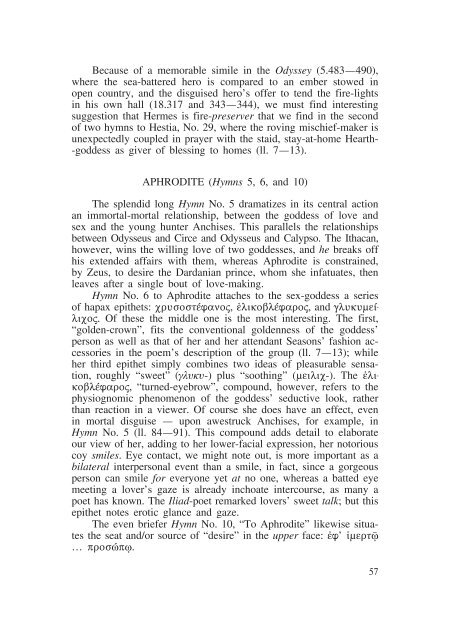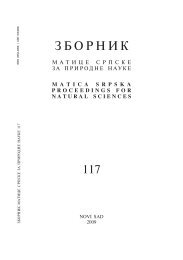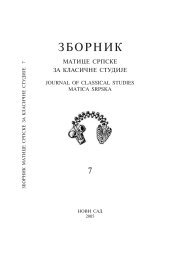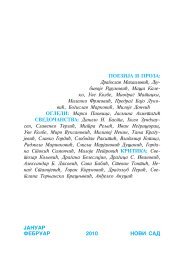Create successful ePaper yourself
Turn your PDF publications into a flip-book with our unique Google optimized e-Paper software.
Because of a memorable simile in the Odyssey (5.483—490),<br />
where the sea-battered hero is compared to an ember stowed in<br />
open country, and the disguised hero's offer to tend the fire-lights<br />
in his own hall (18.317 and 343—344), we must find interesting<br />
suggestion that Hermes is fire-preserver that we find in the second<br />
of two hymns to Hestia, No. 29, where the roving mischief-maker is<br />
unexpectedly coupled in prayer with the staid, stay-at-home Hearth-<br />
-goddess as giver of blessing to homes (ll. 7—13).<br />
APHRODITE (Hymns 5, 6, and 10)<br />
The splendid long Hymn No. 5 dramatizes in its central action<br />
an immortal-mortal relationship, between the goddess of love and<br />
sex and the young hunter Anchises. This parallels the relationships<br />
between Odysseus and Circe and Odysseus and Calypso. The Ithacan,<br />
however, wins the willing love of two goddesses, and he breaks off<br />
his extended affairs with them, whereas Aphrodite is constrained,<br />
by Zeus, to desire the Dardanian prince, whom she infatuates, then<br />
leaves after a single bout of love-making.<br />
Hymn No. 6 to Aphrodite attaches to the sex-goddess a series<br />
of hapax epithets: xrysostçcanoj, Ñlikoblçcaroj, and glykymeålixoj.<br />
Of these the middle one is the most interesting. The first,<br />
“golden-crown", fits the conventional goldenness of the goddess'<br />
person as well as that of her and her attendant Seasons' fashion accessories<br />
in the poem's description of the group (ll. 7—13); while<br />
her third epithet simply combines two ideas of pleasurable sensation,<br />
roughly “sweet" (glyky-) plus “soothing" (meilix-). The Ñlikoblçcaroj,<br />
“turned-eyebrow", compound, however, refers to the<br />
physiognomic phenomenon of the goddess' seductive look, rather<br />
than reaction in a viewer. Of course she does have an effect, even<br />
in mortal disguise — upon awestruck Anchises, for example, in<br />
Hymn No. 5 (ll. 84—91). This compound adds detail to elaborate<br />
our view of her, adding to her lower-facial expression, her notorious<br />
coy smiles. Eye contact, we might note out, is more important as a<br />
bilateral interpersonal event than a smile, in fact, since a gorgeous<br />
person can smile for everyone yet at no one, whereas a batted eye<br />
meeting a lover's gaze is already inchoate intercourse, as many a<br />
poet has known. The Iliad-poet remarked lovers' sweet talk; but this<br />
epithet notes erotic glance and gaze.<br />
The even briefer Hymn No. 10, “To Aphrodite" likewise situates<br />
the seat and/or source of “desire" in the upper face: ñc' ímert~<br />
… pros3p@.<br />
57

















